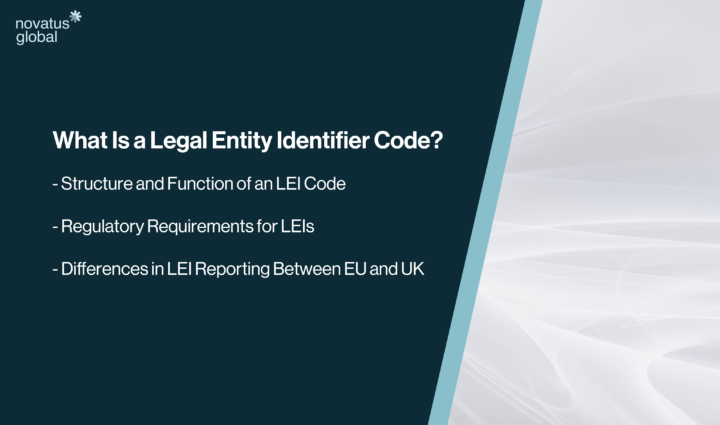
A Legal Entity Identifier (LEI) is a unique, 20-digit, alphanumeric code that is used to identify the legal entities involved in financial transactions. LEIs are structured in line with ISO 17442 standard. LEIs are critical for regulatory purposes and serve to enhance market transparency by offering more granular insights into market participants.
The LEI allows global regulators to track counterparties’ transactions across various jurisdictions and so it plays an important role in reducing systemic market risk. Using an LEI also provides benefits to counterparties by providing enhanced tracking of its activities and thus giving them the ability to reduce their risk exposure. Furthermore, the global use of LEIs has facilitated the creation of a global database of legal entities participating in financial markets.
The Structure and Function of an LEI Code
The primary function of an LEI code is to increase transparency into the activities of market participants in financial markets, and therefore LEI’s inherently assist with regulatory compliance. Each LEI contains certain data elements which help identify each entity participating in a single transaction. The LEI has a standard structure and each character represents an identifier as follows:
-
-
- First 4 digits – LEI Issuer – Identifies the Local Operating Unit that issued the LEI
- Next 14 digits – Entity Identifier – Code specific to the entity, assigned by LEI Issuers
- Last 2 digits – Verification ID – Check digits as outlined in the ISO 17442 standard
-
By providing a unique identifier that can be used on a cross-border basis, all entities participating in financial transactions can also benefit from the increased transparency into who they are transacting with.
Regulatory Requirements for LEIs
Under the Markets in Financial Instruments Regulation (MiFIR), LEIs are mandatory for use in EU and UK markets for investment firms and other entities involved in derivatives trading. The use of LEIs assists Approved Reporting Mechanisms (ARMs) and regulatory authorities by providing transparency and standardisation in regulatory reporting.
Under MiFIR, there are specific guidelines for the kinds of entities that must use an LEI:
-
-
- Investment firms that execute transactions in financial instruments
- Clients who are legal entities and on whose behalf the investment firm executes transactions
- Clients who are legal entities and on whose behalf the trading venue is reportable under MiFIR
- Legal entities who decide to buy the financial instrument, including investment managers acting on behalf of their clients
- Investment firms transmitting the order
- Legal entities submitting a transaction report
- Issuers of any financial instruments listed or traded on a trading venue
-
Differences in LEI Reporting Between EU and UK
Post-Brexit, there are some notable differences in the way that UK firms are subject to compliance with UK MiFIR, including not being able to execute a trade on behalf of a client who is also eligible for an LEI but that has not yet obtained an LEI. Accordingly, firms should establish whether their clients would be eligible for an LEI before acting on their behalf. Clients who qualify as legal entities, such as charities or trusts, should arrange for their own LEI code before instructing the firm to act on their behalf.
While both the EU and UK frameworks require LEIs for transaction reporting, there are minor differences in reporting timelines and formats. The FCA has deviated in some areas from the supervisory approach taken by ESMA and post-Brexit adjustments may apply. Both jurisdictions maintain their own lists of Local Operating Units (LOUs), and firms should ensure compliance with the relevant regulatory authority.
How Do Firms Obtain and Renew an LEI Code?
Firms must apply for an LEI through an approved Local Operating Unit (LOU). Firms can access a list of LOUs on the Global Legal Entity Identifier Foundation (GLEIF) website. The process involves providing specific details that will allow the firm to be identified such as legal name, registered address and corporate ownership information. Once issued, an LEI remains valid for 12 months and then must be renewed.
The GLEIF focuses on ensuring the quality, reliability and usability of LEI data. There are many benefits for the wider business community and as such the GLEIF makes it easy for firms to search for LEIs of their counterparties and clients. Penalties will be imposed if LEIs are not renewed and so it is important for firms to stay up to date with their LEI status.
Firms who are obliged to apply for or maintain an LEI code should register or renew as soon as possible to avoid disruptions and remain compliant.
Legal Entity Identifier FAQs
LEI stands for Legal Entity Identifier, these are unique, 20-digit alphanumeric codes that identify the legal entities involved in a financial transaction.
An LEI code contains unique and identifying information about each legal entity involved in the financial transaction. This information is embedded in codes that are structured in the LEI, and represent an individual corporation, investment firm or other legal entity involved in the transaction. This includes information about holding companies which provides full transparency over the parties involved and is important for market transparency.
Only legal entities are eligible for LEIs and in most cases, individuals cannot be registered with an LEI, unless representing a business. To obtain an LEI for your firm, you apply through a Local Operating Unit (LOU).
Legal Entity Identifier codes are valid for one year, after which they expire and must be renewed to avoid penalties.
Failure to maintain an active LEI when required can lead to regulatory action. This could be in the form of trading restrictions, financial penalties or compliance issues.












